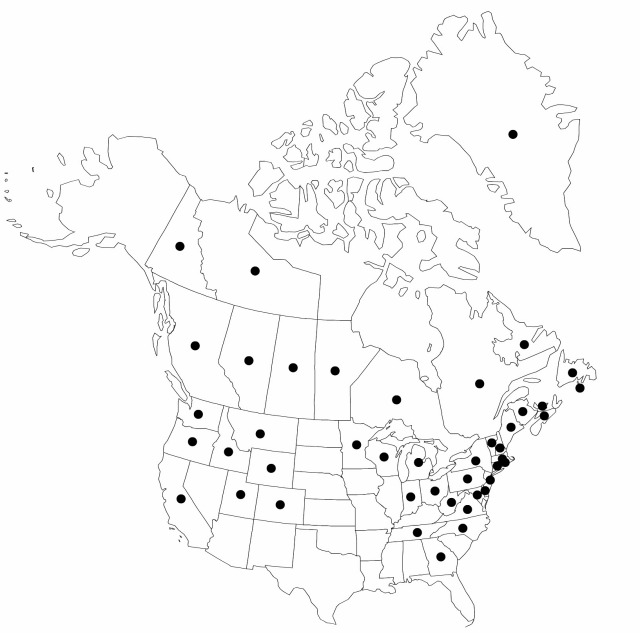Carex brunnescens
in J. Lamarck et al., Encycl., Suppl. 3: 286. 1813.
Plants densely cespitose, in small clumps; rhizomes short. Culms erect to arching, slender, 15–90 cm. Leaves: sheaths relatively tight, pale to mid brown abaxially, inner band thin and hyaline, often concave at summit; ligules as long as wide; blades green to yellowish green, flat, 10–25(–40) cm × 0.5–2 mm, shorter than culms. Inflorescences erect to somewhat nodding, 1.5–7 cm × 3–6 mm; proximal bracts bristlelike-prolonged, shorter than to exceeding spikes; distal bracts usually scalelike. Spikes 5–10, gynecandrous, proximal ± separate, distal closely approximate, containing 5–10 perigynia, sessile, globose to short-oblong, 3–7 × 3–4 mm; terminal spike staminate for less than 1/2 of length, scarcely clavate. Pistillate scales white-hyaline with green, 3-veined center, often brown tinged, ovate, subequal to, not concealing perigynia, apex obtuse to acute. Perigynia appressed-ascending to loosely spreading at maturity, green or brown, often dark brown in age, lightly several-veined, elliptic-ovate, 2–2.5 × 0.8–1.5 mm, widest near middle, membranous; beak shor, margin serrulate. Achenes pale to mid brown, ovate-orbiculate, 1.25–1.5 × 0.8–1 mm, glossy. 2n = 56.
Distribution

Alta., B.C., Man., N.B., N.S., N.W.T., Ont., P.E.I., Que., Sask., Yukon, Calif., Colo., Conn., Del., Ga., Idaho, Ind., Maine, Mass., Md., Mich., Minn., Mont., N.C., N.H., N.J., N.Y., Ohio, Oreg., Pa., R.I., Tenn., Utah, Va., Vt., W.Va., Wash., Wis., Wyo., Eurasia.
Discussion
Subspecies 2 (2 in the flora).
Carex brunnescens is variable across its wide distribution; it deserves a monographic treatment. Many taxa have been described. Most variation is presumably of ecophenotypic nature; when growing in shady habitats the species is slender and weak and the scales are not or but little colored; in more exposed sites it is stiffer, and the scales become strongly brownish tinged. Only two subspecies are recognized here. Subspecies alaskana and subsp. pacifica (see A. Kalela 1965) seem to grade to the typical subsp. brunnescens. A short-leaved plant with short and red tinged perigynia from western United States (Colorado, Montana, Utah, Wyoming) may represent a southern subspecies and should be studied in greater detail.
Selected References
None.
Key
| 1 | Culms usually erect or, sometimes, nodding; leaves (1–)1.5–2.5 mm wide; terminal spike ellipsoid to subclavate. | Carex brunnescens subsp. brunnescens |
| 1 | Culms ascending to arching; leaves (0.5–)1–1.5 mm wide; terminal spike often clavate. | Carex brunnescens subsp. sphaerostachya |